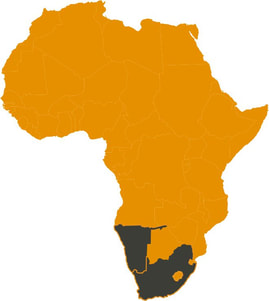Black rhinos are critically endangered with an estimated number of only fewer than 6 000 black rhinos left in the wild.
The Namibian black rhino is the largest of all the subspecies, adapted to arid conditions and are found in an open access landscape not in any zoo or captive breeding facility.
As recently as the 1960s, it was estimated that over 100,000 black rhino were still roaming Africa. Poaching, combined with habitat loss has decimated these populations. After black rhino numbers reached their lowest point in 1995, they have since steadily increased over the past years. Today it is estimated that there are more than 6000 black rhinos left in the wild, and with poaching sweeping across the continent, the critically endangered black rhinos' last stand may be in north-western Namibia which hosts the only free-roaming population of the species.
(Thank you to the World Animal Foundation for updated statistics)
(Thank you to the World Animal Foundation for updated statistics)
- A UNIQUE SPECIES -
|
Desert-adapted black rhino were historically found across Namibia and into western South Africa. They now roam free on approximately 25 000 km ² (5.7 million acres) of arid communal range lands in the Kunene region. Desert-adapted black rhino are genetically similar to other south-western black rhino primarily found across Namibia and a few locations in South Africa.
90% of this unique sub-species are primarily found in the north-west and north-central Namibia. |
COMMON NAMES
Black rhinoceros
Rhinoceros means ‘nose horn’ and refers to the horn that appears to stick out from the rhino’s nose. Black rhinos are not black. The species probably derives its name as a distinction from the white rhino and/or from the dark-colored local soil that covers its skin after wallowing in mud.
Prehensile or hook-lipped rhinoceros.
The upper lip of the black rhino is adapted for feeding from trees and shrubs.
Rhinoceros means ‘nose horn’ and refers to the horn that appears to stick out from the rhino’s nose. Black rhinos are not black. The species probably derives its name as a distinction from the white rhino and/or from the dark-colored local soil that covers its skin after wallowing in mud.
Prehensile or hook-lipped rhinoceros.
The upper lip of the black rhino is adapted for feeding from trees and shrubs.
SCIENTIFIC NAME OF ORIGIN
Diceros bicornis
Dicero from the Greek “di”, meaning "two" and “ceros”, meaning "horn" and “bicornis” from the Latin “bi”, meaning "two" and “cornis”, meaning "horn."
Dicero from the Greek “di”, meaning "two" and “ceros”, meaning "horn" and “bicornis” from the Latin “bi”, meaning "two" and “cornis”, meaning "horn."
PHYSICAL CHARACTERISTICS
Size
Horn
Other Features
Save the Rhino Trust Facts
- Weight: 1,750 - 3,000 lbs (800 - 1,350 kg)
- Height: 4.5 - 5.5 ft (1.4 - 1.7 m) tall at shoulder
- Length: 10- 12.5 ft (3.0-3.8m) length of head and body
Horn
- Black rhinos have two horns. The front horn is larger and measures 20 - 55 inches (0.5 - 1.3 m). The rear horn is smaller and measures up to 22 inches (55 cm) long.
- The longest rhino horn every recorded measured 4 feet 9 inches long but usually average less than 2 feet.
Other Features
- Relatively broad snout with a prehensile lip adapted for grasping branches and leaves.
- Rhinos can run faster than the fastest human sprinters.
- Black rhino's are the third biggest of the five types of rhino.
- Rhino's run on their toes.
- They can cover 100 meters in less than 8 seconds.
- Rhino's do not have very good eyesight but can detect a human figure from roughly 100 yards.
- They are currently listed as critically Endangered.
Save the Rhino Trust Facts
- The size of unfenced land where our Black Rhino's Roam: 1 Million Hectares / 2.5 Million Acres.
- We have a 100+ protectors! They include SRT trackers and Community Rangers.
- Our field teams cover more than 34 000km in a year.
- Our different teams have spent more than 6 100 days in the field all together.
Stay in Touch
Like us on Facebook, Twitter and Instagram to keep up with our news and efforts to Save the Rhino!

